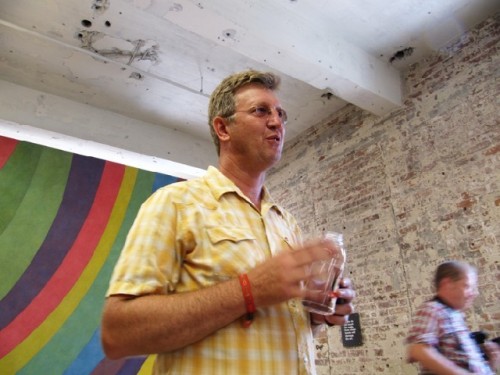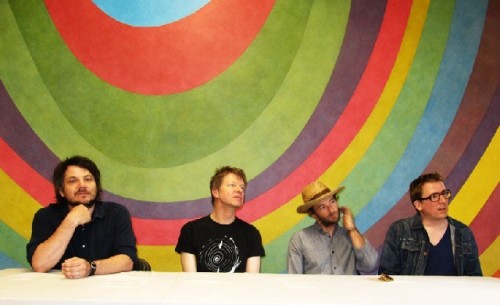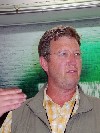MoCA Director Joe Thompson on Wilco
Debriefing the Third Solid Sound Festival
By: Charles Giuliano and Joe Thompson - Jun 29, 2013
Charles Giuliano You have created a remarkable synergy of rock and roll and fine arts. How does that work as a strategy of developing younger audiences for contemporary art?
A lot of folks from the festival took time off from listening to music to wander through the galleries.
Joe Thompson We’ll have to wait and see if they come back but they definitely enjoyed the galleries. We know that. Thousands and thousands and thousands of them visited not just once but many times.
They came for all kinds of complex reasons. They heard about art on the walls. They heard from their friends. They wanted to see Pat Sansone’s pop up performance in front of Jason Montgomery’s big slabs. Or they wanted to catch a few minutes of air conditioning.
They came in for all kinds of reasons but yeah I think we captured a few people’s imaginations.
CG We were seated in the back on the grandstand. Near us we chatted with Nancy Jane Fitzpatrick who indicated that an area of law chairs was set for board members. How are you working with them in terms of your vision of the museum with its merger of rock festivals and fine arts?
JT You’ve written two nice reviews which go pretty deep so you know that Wilco is an unusual group of musicians. The depth and breadth of their musical interests and art are unique. It’s astounding they range from Glenn Kotche and Nels Cline’s explorations of new music. Mikael Jorgensen’s interest in new works which are kind of soundscapes and pop electronica. Every one of them has an unusual take on art.
I thought Jeff Tweedy’s installation was nothing short of brilliant. He put on five or six tracks that you could only hear in the museum. Much like a work of art. To experience it you had to go to a certain place and spend a certain amount of time standing there before it. By playing tracks that the public has only heard at a particular place. Building 8 at Mass MoCA. He’s radically against the grain of broadcasting on every conceivable channel on line to radio to cd sales. He’s localized and narrowly cast the musical experience and put it in a particular place. You couldn’t tape it. You couldn’t record it. You just had to put on the head phones and listen. That’s really interesting and original research. The people that follow these guys have an equally broad range of taste.
I’ve sometimes thought can you do another festival with another band? That have the same kinds of interaction between their audiences and the band? Something that truly does cross over visual arts and musical arts. The answer to that may be, surprisingly, no.
It’s an absolutely fabulous audience which is exceedingly respectful of the art, of the place. Except for some trash on the field after Saturday night the campus and the town are left almost spotless. It’s an indicator of the respect, engagement and interest that they show for the entire place and the arts on the walls.
Our board is really excited about this. We do see this as an opening to whole new audiences. Clearly seen geographically. We had people from 44 states and 18 countries. There was a heavy international visitation this time. It was surprising the number of people from France, Great Britain and Germany.
They come from all across the country. That’s a draw that doesn’t happen every day. Mass MoCA typically gets 30% Boston and 30% New York. For Solid Sound it was more like 20% each. This is far more geographically diverse.
CG How much of a local audience was there?
JT I haven’t gotten the numbers yet. We sold about seven thousand two hundred tickets in all. Berkshire County was roughly ten percent of that. Around 750 tickets.
CG You had an enormous amount of development and startup costs for the first year. To create Joe Thompson Field and put in the infrastructure you needed. Initially you lost money. This is the third time around. Are you in the black?
JT We haven’t yet counted it all up. We spent a lot again this year. You always seem to spend a lot. We added a lot of fencing and did a lot of work on grading and landscaping as well as drainage. There are things that you don’t see like trying to keep places dry when it’s wet.
It seems like a huge amount of money coming in but it’s also a huge amount of money going out. The rentals for the stage equipment. Bringing in a few hundred musicians. Lodging them for three or four days. Paying for travel and fees it goes fast. I think we have a really good shot of at least breaking even.
Nice things happen. The band was incredibly generous. They let us have a couple of fund raisers during the event. Food oriented events and we may have picked up some money there.
There’s a good chance of tipping over into the black this year. We’re all hopeful. It’s not a huge money maker. Certainly not for the band. Not for the museum. We hope it brings a lot of dollars into the town. People come and stay and fill every motel, hotel room and camp ground. The restaurants are all overflowing. I heard lots of stories about people who were just sold out. It probably brings lots of money in that lands in pockets all throughout the county.
CG You indicate landscaping, drainage and things that we don’t see. That also implies to me that you are constantly developing the infrastructure. At some point you have a terrific facility.
JT It’s getting there. The first year we had perfect weather. You almost wanted to bottle it. The second year was disrupted by torrential rain storms which really challenged our systems.
CG We stood through that Friday night concert, with ponchos, and still got soaked.
JT It was a great concert. Some folks say that’s the one that sticks in the mind. This year we had great weather although it was obviously a little hot on Sunday. We’re trying to make improvements in comfort and safety. We’re figuring out crowd circulation. On Saturday in addition to ticket holders, if you add our staff, vendors, the musicians, their entourages and families of which there were a lot we probably had 7,800 on the field. That was the peak on Saturday night around 8 to 9 PM. That felt about right to us in terms of the total number. Saturday afternoon was comfortably snug in the courtyards. You wouldn’t have wanted more. The event felt good and full.
On Sunday afternoon people leave to go back to work so there is a natural fall off.
CG I reported that looking around it seemed like a Tanglewood James Taylor concert. Their capacity is 12,000.
JT We didn’t have that many it was more like 7,800. The field could probably hold more. It was packed with people who wanted to be close to the stage. Back where you and I were sitting there was plenty of room. It was totally comfortable. You could probably get another couple of thousand people in there if you want. The issue is circulation getting in and out. What happens on Saturday afternoon in the passage ways between the courtyards? That’s really the constraint. Not so much the field.
CG Would you cap it at 8,000?
JT Yeah that’s about right. We could fit a few hundred people more. We stopped selling the three day passes and Saturday only passes on Thursday. We considered ourselves sold out. Our partners, band members and staff felt we were getting close to the right numbers.
CG Did you calculate a critical number of tickets that had to be sold to break even?
JT Not really. That may have been a smarter way to do it. Both the band and the museum want to keep tickets affordable. It’s well priced. Early bird three day passes were $99. If you lived locally and bought tickets at the box office you didn’t even have to pay the $8.50 handling fee. That’s a cheap ticket.
Toward the end we were really just gut checking how many do we think we can fit? Is it going to get too crowded? Both the band and the museum are intent on making this a comfortable, enjoyable event. For a lot of music festivals you are packed into a field someplace. You’re jostled around in a horror show of mud and humanity. On the one hand its memorable but you do it once or twice and that’s it.
We hope besides great music and really great art it’s a civilized experience; comfortable, safe. You’re able to take refuge in the museum and see art. There’s a whole vibe that’s very central to this.
Frankly we were nervous. In the 2011 version we had about 5,500 people. The first year in 2010 we had 3,500. We had room to grow from 5,500 people but we will not be adding aanother 2,000 to our 7,200 (7,800 with comps) that’s for sure.
If and when we do this again.
CG Explain if and when. What does that mean?
JT This is kind of a series of one night stands. We’re committed to each other artistically but we don’t make far reaching commitments to dates. We agree to chat with each other. Not this week or next. The band is now on tour with Dylan for six to eight weeks. After they return and have a chance to get settled with their families and decompress we’ll probably pick up the conversation in September. We’ll look at our schedule and they’ll look at theirs.
They all have complicated travel and production lives. The museum also has a complicated schedule we put together. We’ll put our calendars together and try to find a date that works. There are two dates that are key for both of us. Finding a date for the festival itself. Secondly there’s a period from November through January when we’re working hard on the program. We all need time to do that. It’s critical for the band. If they’re traveling heavily at that time it’s difficult for them to do the core of the work which is the programming. Then it gets hard to do.
There’s nothing to announce other than to say we both enjoyed ourselves immensely. The museum staff had a great time. Our board enjoyed it. The audience had a great time. The band, every one of them, told me that they had a ball.
We’re looking forward to picking up the conversation and that’s where we are.
CG To what extent are you now in the festival business? I understand the unique relationship with Wilco but you have the infrastructure to entertain other forms of festivals.
JT We actually have three festivals. The one that we have been doing longest and is near and dear to us, although obviously on a much different scale, is Bang on the Can. That’s a three week festival punctuated by a couple of large concerts on two different Saturdays. That’s in July. We have Wilco’s Solid Sound and the past couple have been in June. The Fresh Grass Festival takes place in September.
It leaves a couple of potential festival months open. These festivals take so much work that I can’t imagine doing more than one a month or more than one every six to eight weeks.
CG There are other art forms that might be explored. A film festival seems very doable, also possibilities for theatre and dance. Not on the scale of Solid Sound but you have a facility available. The potential is there to explore.
JT I’m really interested in it. Every summer during a normal week in the summer, if you add them up we often have one performing arts event and often two or three. If you add them all up they easily equal a series of weekly festivals. We get between three and four thousand people. There’s something about doing it all in two days. That for sure brings another whole level of octane. We always have our ears to the ground.
I bet we get between ten and fifteen proposals a year. From various people, artists, musicians. We think about them and tend to be selective. We never say never.
CG A film festival would seem to be a no brainer. You have the Hunter Center and other indoor spaces and have also screened films outdoors. That would seem to be relatively simple and cost effective with minimal staffing and needs for special equipment.
JT Absolutely. Film is very interesting. I’ve always been interested in comedy. A comedy festival would be possible. You know we have a couple of very strong film festivals with Berkshire International Film Festival and the Williamstown Film Festival. They both do excellent work. We’re co host with both of those film festivals. Both of them have events at Mass MoCA. We’re pleased to have events with other institutions. We are careful about not going one step too far.
CG You collaborate with Jacob’s Pillow.
JT We collaborate in three different ways. We typically do a fall or spring co presentation. It’s part of the Irene Hunter Fund for Dance. It brings a performer or company that probably neither of us could do on our own. It occurs at a time of year when it could not happen at the Pillow because they’re a summer only facility.
Secondly we co host a dance residency. Often with an individual or company which is an emerging artist. We give them time to develop a new work.
Also, two or three times a year we have participatory dance parties. They start with 30 minutes of lessons and then the dance event.
Thompson on Five Year Plan for MoCa



